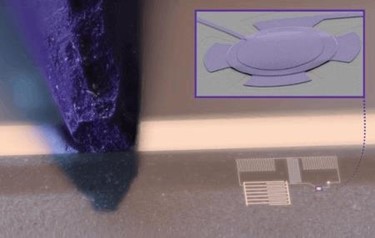EPFL Researchers Turn Mechanical Oscillator Into Quantum Reservoir
By Jof Enriquez,
Follow me on Twitter @jofenriq

Scientists at Ecole Polytechnique Fédérale de Lausanne (EPFL) have successfully demonstrated that cooling a mechanical oscillator close to its quantum ground state will turn it into a quantum reservoir that can shape the states of microwave photons in a superconducting circuit. It's the latest attempt to harness microwaves for quantum information processing.
"There has been a lot of research focus on bringing mechanical oscillators into the quantum regime in the past few years." says Dr. Alexey Feofanov, postdoctoral researcher on the project, which was carried out at Tobias Kippenberg’s Laboratory of Photonics and Quantum Measurements at EPFL. "However, our experiment is one of the first which actually shows and harnesses their capabilities for future quantum technologies."
In the experiment, the EPFL scientists coupled a microwave cavity to a mechanical micrometer-size drum (30 microns wide, 100 nanometers thick) which is actually the top membrane (suspended a mere 50 nanometers, or 1/2000th of the diameter of hair) of a capacitor in a superconducting microwave resonator.
"The drum’s position modulates the resonator’s resonance frequency and, conversely, a voltage across the capacitor exerts a force on the micro-drum. Through this bidirectional interaction, energy can be exchanged between mechanical vibrations and the microwave oscillations in the superconducting circuit," states a news release.
The micro-drum first is cooled close to its quantum ground state by an appropriately tuned microwave tone.
"Every microwave photon (a quantum of light) carries away the energy of a phonon (a quantum of mechanical motion) such that the mechanical energy is reduced. This cooling process increases the dissipation and turns the micro-drum into a dissipative reservoir for the microwave resonator," explains the EPFL release.
The results are two-fold: producing a maser (microwave laser), and manipulating and amplifying microwaves in the quantum regime.
"By tuning the coupling to this dissipative mechanical reservoir, we demonstrate dynamical backaction control of the microwave field, leading to stimulated emission and maser action. Moreover, the reservoir can function as a useful quantum resource, allowing the implementation of a near-quantum-limited phase-preserving microwave amplifier," wrote Feofanov and co-authors László Dániel Tóth, Nathan Bernier, Andreas Nunnenkamp, and Tobias Kippenberg, in the journal article appearing in Nature Physics.
According to the researchers, this EPFL project "extends the toolbox of quantum manipulation techniques of the microwave field" and enables new optomechanical protocols, such as those used to allow noiseless microwave routing or microwave entanglement.
